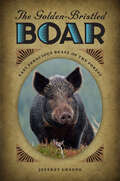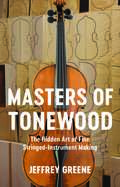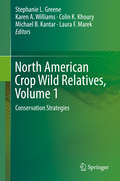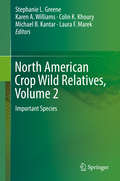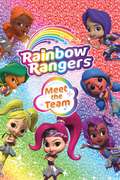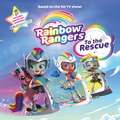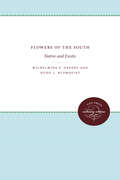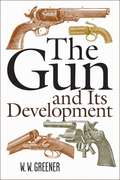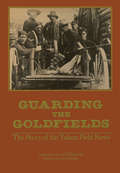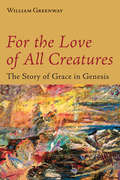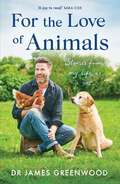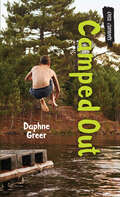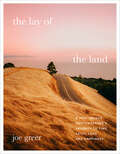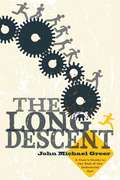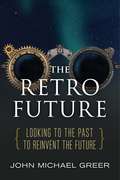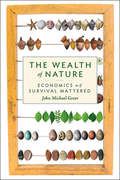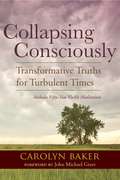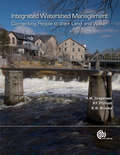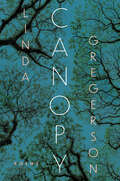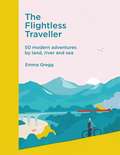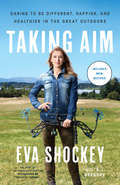- Table View
- List View
The Golden-Bristled Boar: Last Ferocious Beast of the Forest
by Jeffrey GreeneThe wild boar appears to us as something straight out of a myth. But as Jeffrey Greene learned, these creatures are very real, living by night and, despite shrinking habitats and hordes of hunters, thriving on six continents. Greene purchased an eighteenth-century presbytery in a region of ponds and forests in northern Burgundy between the Loire and Seine Rivers of France. He soon discovered he’d moved to one of the most densely populated boar areas in Europe. Following the gift of a side of boar from a neighbor, and a dramatic early-morning encounter with a boar-hunting party and its prey, Greene became fascinated with the animal and immersed himself in the legend and the reality of the wild boar. Although it has no natural enemies, the boar is in constant conflict with humans. Most societies consider it a pest, not only wreaking havoc on crops and livestock, but destroying golf-course greens in search of worms, even creating a hazard for drivers (hogs on the roads cause over 14,000 car accidents a year in France). It has also been the object of highly ritualized hunts, dating back to classical times.The animal’s remarkable appearance--it can grow larger than a person, and the males sport prominent tusks, called "whetters" and "cutters"--has inspired artists for centuries; its depictions range from primitive masks to works of high art such as Pietro Tacca’s Porcellino and paintings by Velázquez and Frans Snyders. The boar also plays a unique role in myth, appearing in the stories of Hercules and Adonis as well as in the folktale Beauty and the Beast.The author’s search for the elusive animal takes him to Sardinia, Corsica, and Tuscany; he even casts an eye to the American South, where he explores the boar’s feral-pig counterparts and descendents. He introduces us to a fascinating cast of experts, from museum curators and scientists to hunters and chefs (who share their recipes) to the inhabitants of chateaux who have lived in the same ancient countryside with generations of boars. They are all part of a journey filled with wonders and discoveries about these majestic animals the poet Robinson Jeffers called "beautiful monsters."
Masters of Tonewood: The Hidden Art of Fine Stringed-Instrument Making
by Jeffrey GreeneThe wood used by master craftsmen to create many of the world’s legendary stringed instruments—violins and cellos, mandolins and guitars—comes from seven near-mythic European forests. In his latest book, Jeffrey Greene takes the reader into those woodlands and into luthiers’ workshops to show us how the world’s finest instruments not only contribute to great musical art but are prized works of art in themselves.Masters of Tonewood describes the "hidden life" of stringed instruments, beginning with the unique wood, expertly chosen and sometimes cured for decades, that gives them voices that rivet audiences. Greene takes us to forests in Italy, France, Switzerland, Austria, Romania, Poland, and the Czech Republic. We are introduced to the acoustical and aesthetic properties of the spruce that Stradivari treasured, and the mystery of why just one in a thousand maple trees contains decorative figuring worthy of the highest-quality instruments. Greene visits the greatest traditional centers of this craft, from Spain to the United States. He recounts the ideas and experiences of tonewood millers, luthiers, and musicians and discusses their concerns about environmental issues associated with a tradition dependent on ancient woodlands in a modern world.
North American Crop Wild Relatives, Volume 1: Conservation Strategies
by Stephanie L. Greene Karen A. Williams Colin K. Khoury Michael B. Kantar Laura F. MarekThe plant species that humans rely upon have an extended family of wild counterparts that are an important source of genetic diversity used to breed productive crops. These wild and weedy cousins are valuable as a resource for adapting our food, forage, industrial and other crops to climate change. Many wild plant species are also directly used, especially for revegetation, and as medicinal and ornamental plants. North America is rich in these wild plant genetic resources. This book is a valuable reference that describes the important crop wild relatives and wild utilized species found in Canada, the United States and Mexico. The book highlights efforts taken by these countries to conserve and use wild resources and provides essential information on best practices for collecting and conserving them. Numerous maps using up-to-date information and methods illustrate the distribution of important species, and supplement detailed description on the potential value these resources have to agriculture, as well as their conservation statuses and needs. There is broad recognition of the urgent need to conserve plant diversity; however, a small fraction of wild species is distinguished by their potential to support agricultural production. Many of these species are common, even weedy, and are easily overshadowed by rare or endangered plants. Nevertheless, because of their genetic proximity to agriculturally important crops or direct use, they deserve to be recognized, celebrated, conserved, and made available to support food and agricultural security. This comprehensive two-volume reference will be valuable for students and scientists interested in economic botany, and for practitioners at all levels tasked with conserving plant biodiversity.The chapters 'Public Education and Outreach Opportunities for Crop Wild Relatives in North America' and 'Genetic Resources of Crop Wild Relatives – A Canadian Perspective' are open access under a CC BY 4.0 license via link.springer.com.
North American Crop Wild Relatives, Volume 2: Important Species
by Stephanie L. Greene Karen A. Williams Colin K. Khoury Michael B. Kantar Laura F. MarekThe plant species that humans rely upon have an extended family of wild counterparts that are an important source of genetic diversity used to breed productive crops. These wild and weedy cousins are valuable as a resource for adapting our food, forage, industrial and other crops to climate change. Many wild plant species are also directly used, especially for revegetation, and as medicinal and ornamental plants. North America is rich in these wild plant genetic resources. This book is a valuable reference that describes the important crop wild relatives and wild utilized species found in Canada, the United States and Mexico. The book highlights efforts taken by these countries to conserve and use wild resources and provides essential information on best practices for collecting and conserving them. Numerous maps using up-to-date information and methods illustrate the distribution of important species, and supplement detailed description on the potential value these resources have to agriculture, as well as their conservation statuses and needs. There is broad recognition of the urgent need to conserve plant diversity; however, a small fraction of wild species is distinguished by their potential to support agricultural production. Many of these species are common, even weedy, and are easily overshadowed by rare or endangered plants. Nevertheless, because of their genetic proximity to agriculturally important crops or direct use, they deserve to be recognized, celebrated, conserved, and made available to support food and agricultural security. This comprehensive two-volume reference will be valuable for students and scientists interested in economic botany, and for practitioners at all levels tasked with conserving plant biodiversity.
Rainbow Rangers: Meet the Team (Rainbow Rangers)
by Summer GreeneSummer Greene's Rainbow Rangers: Meet the Team is an original adventure based on the hit animated series on Nick Jr.!Meet seven girls who work as a team. They live in a magical land. They help protect Earth and save the animals. They are the Rainbow Rangers and they are nature’s superheroes!Learn about each Ranger’s personality and power in this character guide. The clear text and colorful illustrations make this book a perfect fit for new and emerging readers. An Imprint Book
Rainbow Rangers: The Quest for the Confetti Crystal (Rainbow Rangers)
by Summer GreeneSummer Greene's Rainbow Rangers: The Quest for the Confetti Crystal is an original picture book inspired by the hit animated series on Nick Jr.--illustrated by Joshua Heinsz and Maxime Lebrun.The Rainbow Rangers, nature’s superheroes, are throwing a party! Floof, their pet prismacorn, is in charge of protecting the very special Confetti Crystal for the celebration. When the crystal disappears, Floof goes on a journey through the rainbow world of Kaleidoscopia to retrieve it. With the help of some new magical friends, can Floof find the crystal and save the day?An Imprint Book
Rainbow Rangers: To the Rescue (Rainbow Rangers)
by Summer GreeneSummer Greene's Rainbow Rangers: To the Rescue is an original adventure based on the hit animated series on Nick Jr.!Kalia calls the Rainbow Rangers, nature’s superheroes, to action! A melting ice floe has separated a polar bear cub from its mother. Rosie Redd, Anna Banana, and Bonnie Blueberry are sent on a rainbow-ride to Earth to save the day. But they'll have to work as a team to reunite this polar bear family!Includes a punch-out, wearable Kaleidocom!An Imprint Book
Flowers of the South: Native and Exotic
by Wilhelmina F. Greene Hugo L. BlomquistThis book is composed of two sections: the first dealing with native wild flowers; the second, with the exotic or cultivated varieties. The descriptions accompanying the illustrations are concise and explicit for purposes of identification, and useful information on flower arranging and cutting is included.Originally published in 1953.A UNC Press Enduring Edition -- UNC Press Enduring Editions use the latest in digital technology to make available again books from our distinguished backlist that were previously out of print. These editions are published unaltered from the original, and are presented in affordable paperback formats, bringing readers both historical and cultural value.
The Gun and Its Development (Greenhill Military Paperback Ser.)
by W. W. GreenerFirst published in Great Britain in 1881 and subsequently revised nine times between then and 1910, The Gun and Its Development traces the fascinating history of weaponry: the obscure, ancient origins of the slingshot and the bow, the invention of the crossbow, possibly around 1000 AD; the introduction of gunpowder into Europe in the fourteenth century; the development of sporting and military guns over the centuries thereafter; and the rise of modern, mass-produced firearms in the early twentieth century.Chapters cover early to modern handguns; gunpowder ignition methods from fuses and flintlocks to percussion fulminates; shotguns; hammerless guns; ejector guns; the history of the firearms industry; manufacturing methods and their development in Britain, America, and elsewhere; how to use and handle different types of guns; ballistics; the development of rifling and smokeless powder; and much more. Copiously illustrated with photographs and marvelous engravings, The Gun and Its Development is the classic, authoritative reference work on the subject, certain to be of great interest to marksmen, hunters, gun collectors, and anyone interested in military or industrial history.
Guarding the Goldfields: The Story of the Yukon Field Force
by Brereton GreenhousCanada’s gold rush of the late 1890s attracted dreamers and schemers from all over North America. Guarding the Goldfields is the story of the men sent to guard the Yukon and maintain order.
Polar Bears (Nature's Children)
by Caroline GreenlandDescribes the physical features, habits, and natural environment of the Nanook, Ice Bear or more commonly known as The Polar Bear.
For the Love of All Creatures: The Story of Grace in Genesis
by William GreenwayFresh biblical take on a transcending, divine grace that embraces all of God's creatures This broad-ranging, groundbreaking book by William Greenway unfolds a biblical spirituality centering on love for all creation and all creatures. Greenway rereads the creation and flood narratives in Genesis from an overtly creature-loving perspective that not only inspires care for creation but also reveals sophisticated understandings of faith, grace, and evil vital for twenty-first-century spirituality. Comparing the ancient Israelite cosmology of Genesis both with the ancient Babylonian cosmology of the Enuma Elish and with the modern Darwinian cosmology of Thomas Hobbes's Leviathan, Greenway shows how the Bible in Genesis extends far beyond those other cosmologies in its discernment of the transcending, gracious love of God. Standing at the intersection of animal rights, "green" biblical studies, and philosophical theology, Greenway's For the Love of All Creatures will interest and inform a wide range of readers.
For the Love of All Creatures: The Story of Grace in Genesis
by William GreenwayFresh biblical take on a transcending, divine grace that embraces all of God's creatures This broad-ranging, groundbreaking book by William Greenway unfolds a biblical spirituality centering on love for all creation and all creatures. Greenway rereads the creation and flood narratives in Genesis from an overtly creature-loving perspective that not only inspires care for creation but also reveals sophisticated understandings of faith, grace, and evil vital for twenty-first-century spirituality. Comparing the ancient Israelite cosmology of Genesis both with the ancient Babylonian cosmology of the Enuma Elish and with the modern Darwinian cosmology of Thomas Hobbes's Leviathan, Greenway shows how the Bible in Genesis extends far beyond those other cosmologies in its discernment of the transcending, gracious love of God. Standing at the intersection of animal rights, "green" biblical studies, and philosophical theology, Greenway's For the Love of All Creatures will interest and inform a wide range of readers.
For the Love of Animals: Stories from my life as a vet
by Dr James Greenwood'A joy to read' - SARA COXGrowing up in Yorkshire and with farming blood in his genes, James Greenwood always knew he would end up as a vet.Animals have been part of James' life for as long as he can remember, from pulling lambs on a hilltop farm as a child and having stick insects crawling out of his school uniform in class, to renting a flat behind a zoo in Jersey and finding himself treating a newborn baby elephant as a newly qualified vet. Written with his trademark warmth and humour, James offers a fascinating insight into the world of veterinary medicine with tales of treating cats and dogs, horses, pigs and cows, as well as delving deep into his relationship with his beloved and much-missed, one-eyed Labrador, Oliver.However, the path to realising his childhood ambition has not always been easy and at times he has questioned whether it truly is the best job in the world. Through all of the challenging lows and extraordinary highs, it has been the animals themselves that have spurred James on to want to continue vetting and helping him find his calling as a GP vet. Warm, poignant and full of heart, James' story is both a beautiful tribute to the role animals play in our lives and a rare glimpse into what it's really like to be a vet, and is perfect for fans of Matt Baker, The Yorkshire Shepherdess and The Supervet.
For the Love of Animals: Stories from my life as a vet
by Dr James Greenwood'A joy to read' - SARA COXGrowing up in Yorkshire and with farming blood in his genes, James Greenwood always knew he would end up as a vet.Animals have been part of James' life for as long as he can remember, from pulling lambs on a hilltop farm as a child and having stick insects crawling out of his school uniform in class, to renting a flat behind a zoo in Jersey and finding himself treating a newborn baby elephant as a newly qualified vet. Written with his trademark warmth and humour, James offers a fascinating insight into the world of veterinary medicine with tales of treating cats and dogs, horses, pigs and cows, as well as delving deep into his relationship with his beloved and much-missed, one-eyed Labrador, Oliver.However, the path to realising his childhood ambition has not always been easy and at times he has questioned whether it truly is the best job in the world. Through all of the challenging lows and extraordinary highs, it has been the animals themselves that have spurred James on to want to continue vetting and helping him find his calling as a GP vet. Warm, poignant and full of heart, James' story is both a beautiful tribute to the role animals play in our lives and a rare glimpse into what it's really like to be a vet, and is perfect for fans of Matt Baker, The Yorkshire Shepherdess and The Supervet.
Camped Out (Orca Currents)
by Daphne GreerMax knows his mom can't afford to send him to summer camp. But he really, really wants to go. He needs a break from looking after his autistic brother, Duncan. And from his mom's new boyfriend. He is surprised when his mom says that he can go after all. But there's a catch. There are spots available at the camp for families with special needs. A grant would cover Duncan's fees, and Max could attend at no charge. If he goes as Duncan's escort. This is the second story featuring Max and Duncan after Maxed Out.
The Lay of the Land: A Self-Taught Photographer's Journey to Find Faith, Love, and Happiness
by Joe GreerA spiritually uplifting and beautiful designed visual memoir by the hugely popular photographer on Instagram, Joe Greer, combining thoughtful essays and more than 100 gorgeous landscape photos—half fan favorites, and half never-before-seen.“Each photograph really does come down to a split second when you decide to freeze that moment in time. . . . You ask yourself what the story is that you want to tell, and let the rest unfold: Click.”—from the introductionJoe Greer never imagined he would become a photographer. Raised in Florida by an aunt and uncle after his mother’s death when he was four, Joe had a seemingly normal childhood, spending summers at church camp and dreaming of going to college. But nearly fifteen years later, the ground shifted beneath his feet when he discovered a family secret that would impact the rest of his life.Trying to make sense of that revelation and what it meant for his future, Greer set his sights on becoming a pastor at Spokane’s Moody Bible Institute. There, he discovered Instagram—and a passion for photography. His pictures of the lush, wild beauty of the Pacific Northwest landscape attracted a large following that has grown to more than three quarters of a millions fans and continues to expand. The Lay of the Land is Joe’s story in words and pictures. In this stunning compendium, he reflects on the trauma of his early life and what photography has taught him: how to find his light; how to slow down; how to appreciate the world around him, a reverence for the nature world that that both nurtures and amplifies his creativity and faith; how to love—his photography led him to his wife, Madison—and how to heal. For Joe, photography has been a way to find purpose, better understand his faith, and express himself. Though he began with landscapes, meeting his wife sparked a new love of portraiture, and he turned to making photos of street scenes that explored his complicated feelings about family. A love letter to the natural world, to faith, and to finding your calling in the most unexpected places, The Lay of the Land is a window into the beautiful mind and heart of one of the internet’s favorite photographers. Moving and inspiring, it is a creative and spiritual journey that offers lessons on life and living. As Greer reminds us all, whatever it is you want, it’s up to you to make the moment (and the photograph).
The Long Descent: A User's Guide to the End of the Industrial Age
by John Michael GreerAmericans are expressing deep concern about US dependence on petroleum, rising energy prices, and the threat of climate change. Unlike the energy crisis of the 1970s, however, there is a lurking fear that now the times are different and the crisis may not easily be resolved. The Long Descent examines the basis of such fear through three core themes: Industrial society is following the same well-worn path that has led other civilizations into decline, a path involving a much slower and more complex transformation than the sudden catastrophes imagined by so many social critics today. The roots of the crisis lie in the cultural stories that shape the way we understand the world. Since problems cannot be solved with the same thinking that created them, these ways of thinking need to be replaced with others better suited to the needs of our time. It is too late for massive programs for top-down change; the change must come from individuals. Hope exists in actions that range from taking up a handicraft or adopting an "obsolete" technology, through planting an organic vegetable garden, taking charge of your own health care or spirituality, and building community. Focusing eloquently on constructive adaptation to massive change, this book will have wide appeal. John Michael Greer is a certified Master Conserver, organic gardener, and scholar of ecological history. The current Grand Archdruid of the Ancient Order of Druids in America (AODA), his widely-cited blog, The Archdruid Report (thearchdruidreport.blogspot.com) deals with peak oil, among other issues. He lives in Ashland, Oregon.
The Retro Future: Looking to the Past to Reinvent the Future
by John Michael GreerThe author of The Long Descent examines a solution for the troubles of our modern age: technical regression.To most people paying attention to the collision between industrial society and the hard limits of a finite planet, it’s clear that things are going very, very wrong. We no longer have unlimited time and resources to deal with the crises that define our future, and the options are limited to the tools we have on hand right now.This book is about one very powerful option: deliberate technological regression.Technological regression isn’t about “going back”—it’s about using the past as a resource to meet the needs of the present. It starts from the recognition that older technologies generally use fewer resources and cost less than modern equivalents, and it embraces the heresy of technological choice—our ability to choose or refuse the technologies pushed by corporate interests.People are already ditching smartphones and going back to “dumb phones” and land lines and e-book sales are declining while printed books rebound. Clear signs among many that blind faith in progress is faltering and opening up the possibility that the best way forward may well involve going back.A must-read for anyone willing to think the unthinkable and embrace the possibilities of a retro future.Praise for The Retro Future“Whether or not you accept John Michael Greer’s argument that a deindustrialized future is inevitable, you’ll appreciate his call for the freedom to select the best technologies of the past—worthy and sustainable tools, not pernicious prosthetics. Greer’s vision of a “post-progress” world is clear, smart, and ultimately hopeful.” —Richard Polt, professor of philosophy, Xavier University; author, The Typewriter Revolution: A Typist’s Companion for the 21st Century“What might your life be like without an automobile, TV, or a mobile phone? Ask John Michael Greer, who lives that way and recommends it as practice for the soon-to-be-normal. Greer says we are embarked upon the post-progress era. Climate change, loose nukes, and resource exhaustion are among its many challenges. In The Retro Future, Greer looks backward to mark the way forward.” —Albert Bates, author, The Post-Petroleum Survival Guide, The Biochar Solution, and The Paris Agreement
The Wealth of Nature: Economics as If Survival Mattered
by John Michael GreerOur destructive obsession with money and economic growth has driven us to the brink of disaster. The Wealth of Nature exposes the flaws in conventional economic theory and shows how through public policy initiatives and personal choices the economy can be restructured at an appropriate scale with a focus on the natural world.
Collapsing Consciously: Transformative Truths for Turbulent Times (Sacred Activism #3)
by John Michael Greer Carolyn BakerA collection of probing essays and weekly meditations, this book addresses how to prepare emotionally and spiritually for the impending collapse of industrial civilization. Author Carolyn Baker offers wisdom, inspiration, and a sense of spiritual purpose for anyone who is concerned about the daunting future humankind has created.The author's introduction to Collapsing Consciously articulates our current predicament of economic collapse, environmental degradation, and global conflict and expresses the confusion, anxiety, grief, anger, and despair we all experience when we take a hard look at the present-day global crisis and the likely future of the planet. But rather than showing us ways to prevent the collapse, Baker argues that the demise of our consumerist, corporate culture is inevitable, and that it is crucial to prepare emotionally and spiritually for the certain changes to come.Part 1 is a collection of seventeen essays which argue that while the collapse of industrial society cannot be prevented, its meaning extends far beyond tragedy and loss. These essays ask the reader to delve inward and discover the limitless treasures of the soul, as well as the gratification and exhilaration to be discovered in joining with community in preparing for the future.In part 2, Baker offers fifty-two weekly meditations comprised of spiritual wisdom, inspiration, paradox, comfort, humor, irony, and a persistent challenge to create and savor beauty in the world, regardless of how bleak the future may appear.Collapsing Consciously is a refreshing take on the perilous present and the grim prospects for our future. Instead of quoting discouraging statistics about our predicament, Baker offers a deeper perspective that makes sense of a world that most of the time appears psychotic or even surreal. Through inspiration and perennial wisdom she has created a manual for making meaning and generating joy, especially in situations that feel hopelessly devoid of both.An ebook containing additional meditations is also available: Collapsing Consciously Meditations: Further Reflections for Turbulent Times, ISBN 978-1-58394-758-6.From the Trade Paperback edition.
Integrated Watershed Management: Connecting People to Their Land and Water
by Hans M. Gregersen Kenneth N. Brooks Peter F. FolliottGregersen, Folliott, and Brooks provide government agencies and other bodies with background information, factors to be considered, and procedures that facilitate organizing and guiding land and water use in concert with one another. The book can also serve as a reference for planning, monitoring, and implementing development efforts and natural resource management using the integrated watershed management approach. Annotation ©2008 Book News, Inc., Portland, OR (booknews.com)
Canopy: Poems
by Linda GregersonA long-awaited yet startlingly urgent new collection from &“a contemporary master&”*—a fierce, big-hearted eye on our last, tumultuous decade, and our fragile environment *Los Angeles Review of Books Linda Gregerson&’s long-awaited new collection is a tour de force, a compendium of lives touched by the radical fragility of the planet and, ultimately, the endless astonishment and paradox of being human within the larger ecosystem, &“in a world where every breath I take is luck.&” From the Syrian refugee and ecological crises, to police brutality and COVID, to the Global Seed Vault buried under permafrost, the poems ask: How does consciousness relate to the individual body, the individual to the communal, the community to our environment? How do we mourn a loved one, and how do we mourn strangers? The magnificent poems in Canopy catalogue and reckon with humanity and the natural world, mortality, rage, love, grief, and survival.
The Flightless Traveller: 50 modern adventures by land, river and sea
by Emma GreggDiscover how to explore our beautiful world sustainably and responsibly with this trailblazing guide to flight-free travel. Seeking options that are enjoyable and kind to the planet, award-winning travel writer Emma Gregg shows you how to get a no-fly holiday off the ground.The Flightless Traveller presents 50 inspirational, life-affirming trip ideas for those who would like to fly less, or not at all. They include eco-friendly city breaks and coastal retreats, bike rides and sailing voyages, short jaunts on vintage railways and incredible intercontinental journeys.Some shed new light on wonderful, well-known places. Others reveal destinations, activities and experiences you might have never considered before. Best of all, they make the journey an essential part of the adventure.Get ready to recapture the authentic spirit of travel as you plan your next trip by land, river or sea.
Taking Aim: Daring to Be Different, Happier, and Healthier in the Great Outdoors
by A. J. Gregory Eva ShockeyAn acclaimed bow hunter who defies the stereotype that hunting is a man’s game, Eva Shockey is a TV and social media phenomenon at the forefront of a new wave of women and girls who are passionate about outdoor sports. Eva Shockey grew up expecting to be a dancer like her glamorous mother. But something about spending family vacations RV-ing across North America and going on hunts with her dad sparked in her an enduring passion for a different way of life. In Taking Aim, Eva tells a very personal story of choosing the less-traveled path to a rewarding life in outdoor pursuits like hunting and fishing. For her, as her millions of fans can attest, that has meant hunting as a way of harvesting food, caring deeply about conservation, sustainability and healthy eating, and getting closer to God in nature. In this riveting memoir for the adventurer in all of us, Eva takes readers along as she hunts caribou on the rugged Aleutian Islands, tracks a 1,500-pound bull moose across the unforgiving Yukon, and meets many other challenges of a life in the wild. Along the way we learn that hunting is about so much more than pulling a trigger. "My story is about discovering your dream," writes Eva. "It's about following your passion, mastering your skills, taking aim no matter who thinks you’re crazy…and then letting the arrow fly. If you’ve done all you can, I can tell you that you’re almost certain to hit your mark." Whether you’re a lifelong hunter or a city dweller who has never set foot in the wilderness, Eva’s story delivers an empowering message about rejecting stereotypes and expectations, believing in yourself, and finding the courage to pursue what you care about most.
